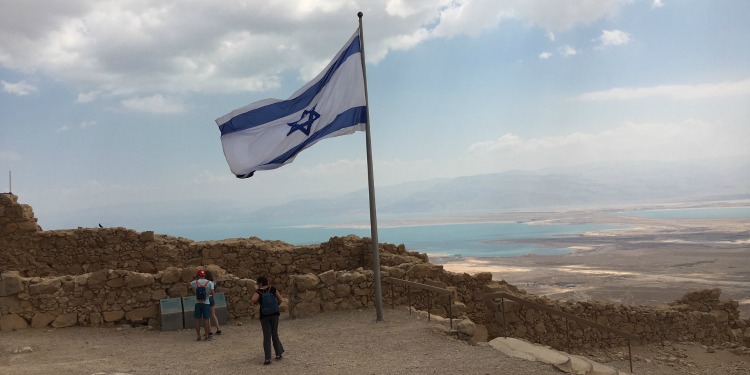Masada Shall Never Fall Again
The Fellowship | May 21, 2018

As our bus wound its way southeast from Jerusalem, the roads were relatively empty because it was Shabbat. The lack of traffic made our trip into the desert breeze by, but the view of the Dead Sea to our left made me want to linger. I needn’t have worried – my views of the Dead Sea would get much better as the day wore on.
Our tour guide Reuven identified meaningful spots as the bus rolled along. Bethlehem, which we had visited earlier. Jericho, with its crops and flocks of sheep and goats. Qumran, where the Dead Sea Scrolls were found. And at last, Masada, a mountain without the usual pointed peak, but instead a flat, plateaued top. It was there we would stop. And it was there we would go to the top.
The group disembarked and headed toward the rocky hill, Reuven telling us that its highest point was only at sea level. But instead of hiking up the winding “Snake Trail” in the already scorching desert sun, we would take cable cars. As we waited for our ride, Reuven pointed out the curious and cacophonous black birds that hopped around, hoping for us tourists to feed them, or at least drop bits of food. These birds, with their high-pitched whistles, loud squawks, and orange on their wings, were Tristram’s grackles. Not having been around humans for millennia, they are only recently discovering to fear people, Reuven explained. This was the first hint at the ancient world we were about to encounter.
Once our cable cars deposited us atop Masada, Reuven began his storytelling, weaving a tale of Jewish resourcefulness and resolve. Masada is a natural fortress, one which genius architect, convert to Judaism, and notorious biblical bad guy Herod the Great turned into a refuge. With any approach nearly impossible for invaders to storm, the only need for those encamped on the mountain was water. And, thanks to Herod’s engineering skills, water was soon available. Damming up the desert canyons when the rainy season came, Herod then had his builders construct a series of pipes that brought water up the mountain. Once the water was there, it was stored in giant cisterns, which, along with great storehouses of food, meant that Masada’s defenders could outlast any siege. Reuven showed us the cisterns and the storehouses, bringing the rocks and ruins we encountered to life.
Herod’s fortress became a sanctuary for the king, a place where he built lavish gardens and two palaces, which he adorned with art and with concubines. Reuven took us to where Herod’s hanging gardens hung, and where his royal northern palace stood, his words illustrating the sights and sites we were seeing.
After Herod’s death, Reuven told us, Masada ended up in the hands of Jewish settlers. And there it stayed for nearly a century, until the Roman conquest began in the 60s (A.D., of course). After the Roman legions destroyed the Second Temple and began to take over the rest of the Holy Land, they came to this seemingly impenetrable peak. On top lived nearly a thousand Jews, led by Eleazar Ben Ya’ir.
Surrounding Masada’s base, the Roman soldiers, commanded by General Flavius Silva, laid siege to the Jews. At first the Romans tried to build a ramp up the mountain. But they were turned back by rocks and boulders thrown down by the Jewish defenders on high. The Romans then forced Jewish prisoners from other conquered areas to continue the construction, knowing that those at the top would be slow to harm their own.
Once the ramp to the top was complete, the Roman soldiers attacked the fortress walls with a battering ram. The walls began to crumble, and Eleazar’s people reinforced them with wood. And this is when the Romans were finally able to breach Masada. Putting flaming pitch on the ends of their arrows, the attackers set fire to the wooden reinforcements.
And as the invading hordes prepared their final assault, Reuven read us the inspiring words that Eleazar delivered to the Jews atop Masada:
“Since we long ago, my generous friends, resolved never to be servants to the Romans, nor to any other than to God himself, who alone is the true and just lord of mankind; the time is now come that obliges us to make that resolution true in practice…I cannot but esteem it as a favor that God hath granted us, that ’tis still in our power to die bravely, and in a state of freedom. Which hath not been the case of others, who were conquered unexpectedly. ‘Tis very plain that we shall be taken within a days time: but ’tis still an eligible thing to die, after a glorious manner, together with our dearest friends.”
With these powerful words, the Jewish people prepared to stand for what was right. As history tells us, this battle was lost. But as we stood atop Masada, atop this mount where brave Jews once held their ground and stood for good and freedom, Reuven shared with us that IDF units are still sworn in on Masada’s southern point to this day, inspired by Eleazar’s words, as is all of Israel, and affirming that the Jewish state, like “Masada, shall never fall again.”
Read the previous posts about the tour, including visits to Yad Vashem, the Israel Museum, and Yad Lakashish.
